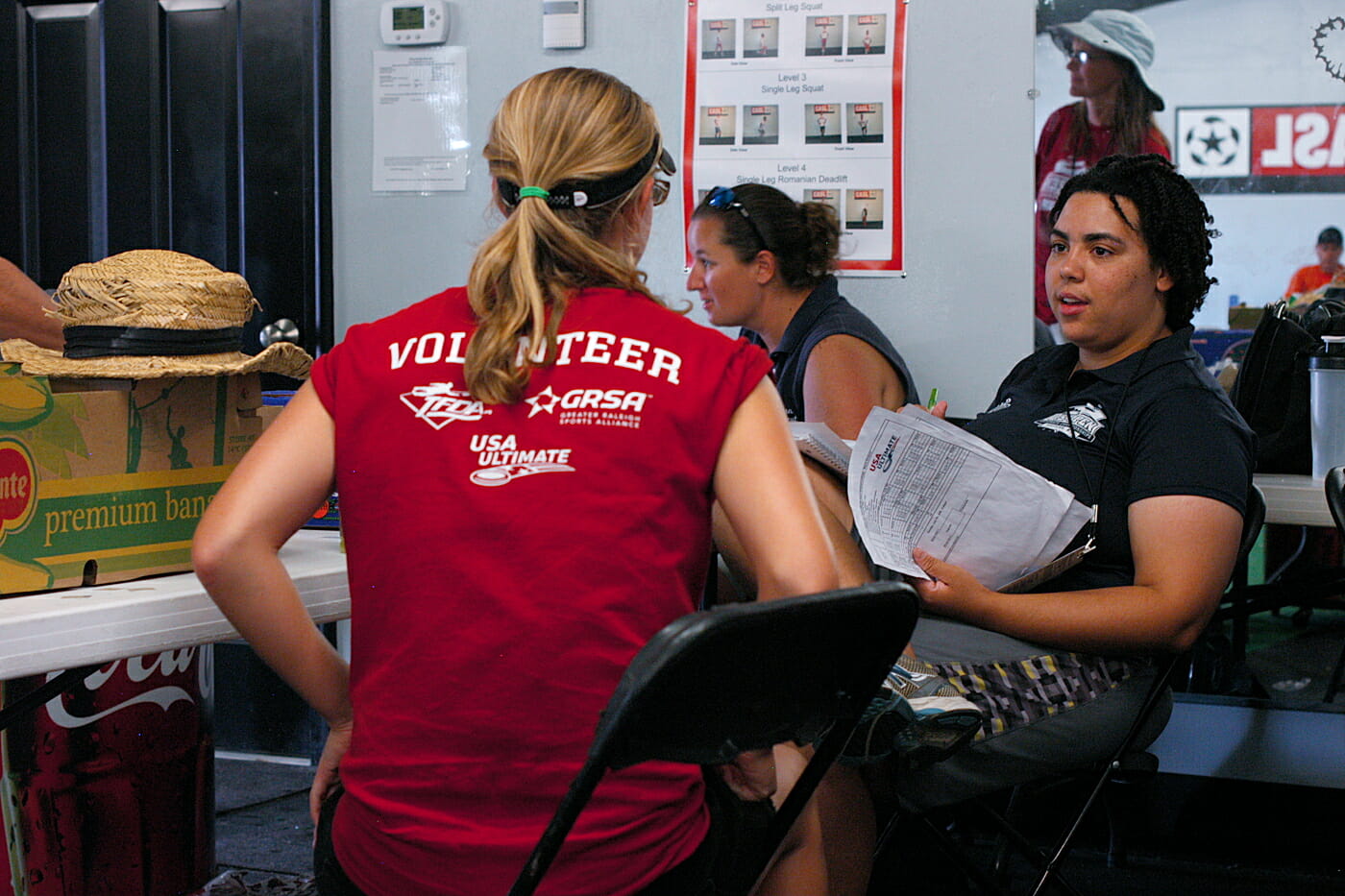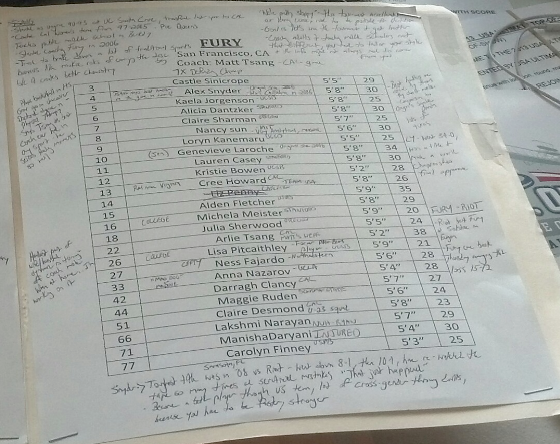Most ultimate players understand what it takes to prepare to play in a tournament, but very few of us have ever hosted one. This is the story of those who worked behind the scenes to ensure that the US Open was the best tournament experience possible.
August 6, 2013 by Josh Hartzog in Other with 9 comments

Most ultimate players understand what it takes to prepare and play at a tournament, but very few of us have ever hosted a tournament. For those who have, even fewer have had the opportunity to host a four-day tournament, including 24 teams from across the globe, while simultaneously coordinating over 150 volunteers. This is the story of those who worked behind the scenes to ensure that all the athletes at the US Open had the best tournament experience possible.
Planning For 24 Teams To Arrive In Raleigh, NC
The bid process began during the fall of 2012, with USA Ultimate contacting potential host communities. Since the US Open contains both a convention and a tournament, it was imperative that the host site contain suitable facilities for both. Raleigh has a brand new convention center and several soccer complexes located within a thirty minute drive, as well as a vibrant downtown area. Once their decision was made in January 2013, USAU worked closely with the Triangle Flying Disc Association (TFDA), the local ultimate governing body running since 1997, in order to organize the tournament. One of the first tasks was to create a thirteen member local-organizing committee (LOC) made up entirely of TFDA members. The purpose of the LOC was to act like the TD of a smaller tournament, but on a much larger scale. Key members included Troy Revell, the tournament director, and Geoff Horsfield, the volunteer coordinator.
One of the key components to running any large sporting event is the recruitment and involvement of volunteers. This was especially true of the US Open, given that there is not a large revenue stream to pay event staff. Volunteer recruitment began months in advance of the tournament with a large portion of volunteers coming from the local YCC teams, Carolina Sky, NC Hammer, Triforce, and Warhawks. Volunteers were assigned tasks on a huge seven-page Google spreadsheet that was constantly being updated. So much of the planning and important information for the US Open was done using Google products that Revell commented that if Google servers were to go down, the tournament might be in jeopardy.
While the LOC and USA Ultimate were hammering out the details of running a huge tournament, the ESPN commentators were preparing for their first broadcast of the Club Division. Preparations began immediately following the College Championships, gradually ramping up to the broadcast days. Both Evan Lepler and Mike Couzens spent hours researching and learning about all twenty-four teams involved in the tournament. This included conversations via email and phone with the captains or coaches of the teams.
“That proved to be a great way to get storylines and learn a lot about the teams before arriving in Raleigh,” said Couzens. “To me, the most important part of the game is the people on the field and the stories that they bring to the table. Where did they play in college? Have they played for other club teams before? How many years have they been with their current team? When did he or she start playing ultimate? What’s the team’s strategy for that particular game? Those are all things that I think add a lot of value to the broadcast.”
Running A Tournament Involving Over 450 Players And 200 Event Staff
Because of the dual nature of the US Open and Convention, games did not start until the late morning or early afternoon in order to give players an opportunity to attend parts of the convention and give presenters the chance to attend games.
One of the first issues to deal with was due to the unusually wet summer that Raleigh had experienced through June and early July. Two fields were not in good playing shape and had to be relocated to turf fields. Two others were not much better, but, without a better option, the decision was made to play on them. For the organizers, Thursday and Friday were certainly the most chaotic days, and having the extra hours in the morning to make sure everything was properly set up for the teams was critical.
USAU staff and volunteers alike would arrive four to five hours before play started to ensure that tents were set up, water buckets filled, and score boards ready for all twelve fields. Many volunteers only helped out for one day so trainings were held each morning in proper golf cart driving etiquette, how to fill out the stat sheets, and who to contact in order to keep score reporter up-to-date.
“Our Volunteer Coordinator, Geoff Horsfield, was basically running the tournament once it started, sending scorekeepers to their fields, keeping the water crews going, managing set up and breakdown crews, and he rocked it out,” said Revell. The largest issue to deal with was making sure that there was plenty of cold water at each of the fields in sweltering North Carolina sun. Water crews were constantly being called to various fields in order to keep the players refreshed, and despite a minor incident of improper golf cart use, the orders were filled promptly. After the games concluded each day, the fields had to be cleaned (not always easy when teams were slow to pack up) and everything prepared for the following day.
As you may have noticed, the ESPN broadcast of the mixed semifinal game between the Polar Bears and Odyssée — the first game on ESPN — began with score tied at 2-2. While trying to position the satellite truck behind the stands, the driver inadvertently got the truck stuck on the fence. When he was unable to get out, a crane was called in to move the vehicle. Evan and Mike in the booth were unaware of the exact issue, but were waiting on standby to begin the broadcast and were able to roll into the game when the truck was ready. The broadcasters arrived at the fields about three hours earlier in order to catch the last of the pool play games and catch a glimpse of the teams they would be covering for the day. Once the teams were set, they spent some more time preparing the story lines, as well as finalizing their charts.

Each broadcaster has their own system, but each consist of a roster with names, numbers, and a lot of handwritten notes. The broadcast itself is definitely the best part of the experience, according to Lepler. “Once we hit the airwaves, it’s just so much fun to try and relax and watch the great ultimate unfold,” he said. “Throughout the day, we tried to share some interesting stories and capture the mood of the day and weekend, but mostly, we’re trying to stay out of the way and let people enjoy the action.”
After each game a short recap was shot, and then put together by the crew, which drove up from Florida for the weekend. Couzens wanted to make sure that the crew got their due as well. “I have to give so much credit to Tom Domer, [director] Mitch Rubenstein, [graphics producer] Tony Pavon, and the rest of the crew for the great job they did over the course of the weekend,” he said. “Tom and Tony were with us in Madison, but Mitch was new to ultimate, and everything went so well on the air. Additionally, the camera crew deserves lots of credit for their work, standing out in the heat and humidity for hours upon hours to help make the broadcast so successful.”
In the end the US Open was a success not only because of the high level ultimate that it provided, but because of the hard work of many individuals and the willingness of those individuals to work together.